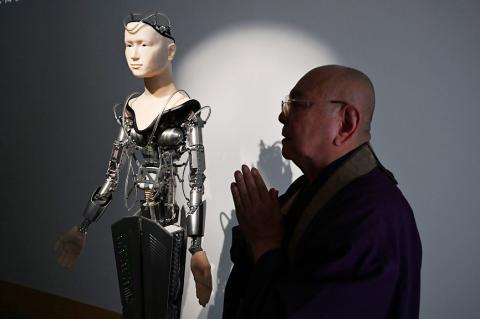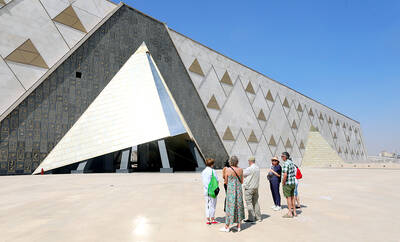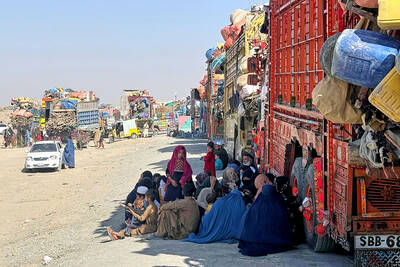A 400-year-old temple in Japan is attempting to hot-wire interest in Buddhism with a robotic priest that it believes will change the face of the religion — despite critics comparing the android to “Frankenstein’s monster.”
The android Kannon, based on the Buddhist deity of mercy, preaches sermons at the Kodaiji Temple in Kyoto, and its human colleagues predict that with artificial intelligence (AI), it could one day acquire unlimited wisdom.
“This robot will never die. It will just keep updating itself and evolving,” priest Tensho Goto said.

Photo: AFP
“That’s the beauty of a robot. It can store knowledge forever and limitlessly. With AI, we hope that it will grow in wisdom to help people overcome even the most difficult troubles. It’s changing Buddhism,” Goto added.
The adult-sized robot, which began service earlier this year, is able to move its torso, arms and head, but only its hands, face and shoulders are covered in silicone to replicate human skin.
Clasping its hands together in prayer and speaking in soothing tones, the rest of the droid’s mechanical parts are clearly visible.
Wiring and blinking lights fill the cranial cavity of its open-top head and snake around its gender-neutral, aluminium body.
A tiny video camera installed in the left eye completes an eerie, cyborg-like frame seemingly lifted straight out of a dystopian Hollywood sci-fi thriller.
Developed at a cost of almost US$1 million in a joint project between the Zen temple and Osaka University robotics professor Hiroshi Ishiguro, the humanoid — called Mindar — teaches about compassion and of the dangers of desire, anger and ego.
“You cling to a sense of selfish ego,” it tells worshippers. “Worldly desires are nothing other than a mind lost at sea.”
With religion’s influence on daily life flat-lining in Japan, Goto hopes that Kodaiji’s robot priest will be able to reach younger generations in a way that traditional monks cannot.
“Young people probably think that a temple is a place for funerals or weddings,” he said, trying to explain the disconnect with religion. “It might be difficult to relate to fuddy-duddy priests like me, but hopefully the robot is a fun way to bridge that gap. We want people to see the robot and think about the essence of Buddhism.”
However, Goto said that Mindar is no gimmick to boost income from tourists.
“This robot teaches us ways to overcome pain,” he said. “It is here to save anyone who seeks help.”
The pious droid delivers sermons from the Heart Sutras in Japanese, with translations in English and Chinese projected onto a screen for foreign visitors.
“The goal of Buddhism is to ease suffering,” Goto said. “Modern society brings other kinds of stress, but the goal hasn’t really changed for more than 2,000 years.”
“Obviously a machine doesn’t have a soul,” Goto said. “But Buddhist faith isn’t about believing in God. It’s about following Buddha’s path, so it doesn’t matter whether it is represented by a machine, a scrap of iron or a tree.”
The temple insists that the deity of mercy is able to transform itself at will and that an android is merely the latest incarnation.
“AI has developed to such an extent that we thought it logical for the Buddha to transform into a robot,” Goto said. “We hope it will touch people’s hearts and minds.”

With much pomp and circumstance, Cairo is today to inaugurate the long-awaited Grand Egyptian Museum (GEM), widely presented as the crowning jewel on authorities’ efforts to overhaul the country’s vital tourism industry. With a panoramic view of the Giza pyramids plateau, the museum houses thousands of artifacts spanning more than 5,000 years of Egyptian antiquity at a whopping cost of more than US$1 billion. More than two decades in the making, the ultra-modern museum anticipates 5 million visitors annually, with never-before-seen relics on display. In the run-up to the grand opening, Egyptian media and official statements have hailed the “historic moment,” describing the

SECRETIVE SECT: Tetsuya Yamagami was said to have held a grudge against the Unification Church for bankrupting his family after his mother donated about ¥100m The gunman accused of killing former Japanese prime minister Shinzo Abe yesterday pleaded guilty, three years after the assassination in broad daylight shocked the world. The slaying forced a reckoning in a nation with little experience of gun violence, and ignited scrutiny of alleged ties between prominent conservative lawmakers and a secretive sect, the Unification Church. “Everything is true,” Tetsuya Yamagami said at a court in the western city of Nara, admitting to murdering the nation’s longest-serving leader in July 2022. The 45-year-old was led into the room by four security officials. When the judge asked him to state his name, Yamagami, who

DEADLY PREDATORS: In New South Wales, smart drumlines — anchored buoys with baited hooks — send an alert when a shark bites, allowing the sharks to be tagged High above Sydney’s beaches, drones seek one of the world’s deadliest predators, scanning for the flick of a tail, the swish of a fin or a shadow slipping through the swell. Australia’s oceans are teeming with sharks, with great whites topping the list of species that might fatally chomp a human. Undeterred, Australians flock to the sea in huge numbers — with a survey last year showing that nearly two-thirds of the population made a total of 650 million coastal visits in a single year. Many beach lovers accept the risks. When a shark killed surfer Mercury Psillakis off a northern Sydney beach last

‘NO WORKABLE SOLUTION’: An official said Pakistan engaged in the spirit of peace, but Kabul continued its ‘unabated support to terrorists opposed to Pakistan’ Pakistan yesterday said that negotiations for a lasting truce with Afghanistan had “failed to bring about a workable solution,” warning that it would take steps to protect its people. Pakistan and Afghanistan have been holding negotiations in Istanbul, Turkey, aimed at securing peace after the South Asian neighbors’ deadliest border clashes in years. The violence, which killed more than 70 people and wounded hundreds, erupted following explosions in Kabul on Oct. 9 that the Taliban authorities blamed on Pakistan. “Regrettably, the Afghan side gave no assurances, kept deviating from the core issue and resorted to blame game, deflection and ruses,” Pakistani Minister of